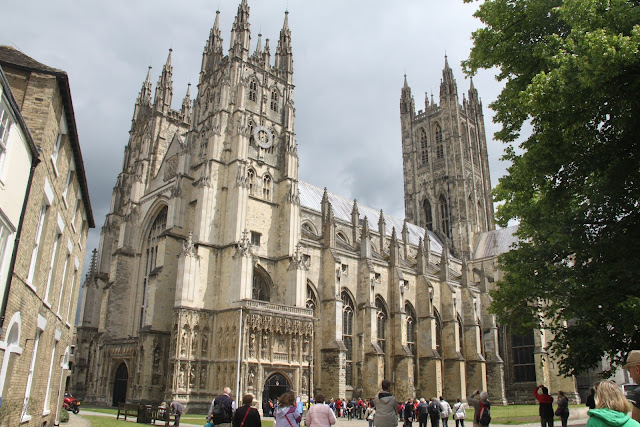

Hidden behind a tiny gate in the old town of Canterbury is the enormous Canterbury Cathedral, seat of the main Archbishop of the Anglican Church (the "Mother Church" for all Anglicans). But despite all this, it's a pretty cool building in itself. I don't think I've been in another cathedral of this sort of size that is split-multi-floored, with the main Nave level and its spectacularly high pillars which splits at the front of the church with a Crypt below (the oldest part of the church) and the Quire and Trinity Chapel on the upper floor. There's also the Chapter House and Cloister to the side and the many other old church buildings.

The cathedral is 72m high in a mixture of Romanesque, English Gothic and Gothic architecture, and was built by William of Sens and William the Englishman. It houses the graves of many people famous in English history from Thomas Becket (who was murdered in the cathedral by minions of Henry II who said "Who will rid me of this turbulent priest?" but probably didn't mean death) to Edward the Black Prince to Henry IV and other royals.


Because of its more than 1400 years of worship (Pope Gregory the Great sent Augustine as his missionary in 597AD) it includes many historical relics. The Normans left their legacy in the Crypt with their typical round Romanesque columns. A fire in the 12th Century led to subsequent rebuilds of the Quire and Trinity Chapel, and much of the beautiful stained glass dates from this time, especially the miracles and stories centering on St. Thomas. The cathedral also had to be significantly expanded to accommodate all the many pilgrims visiting his shrine. The Catholic heritage can be seen in the ruins of the Infirmary, Bakery, Granary, Brewery, which are near to the new Herb Garden. World War II left its own impact -- most of the surrounding town and the cathedral library were flattened and ruined by bombs. In March 1539, it ceased to be an Abbey, and became a 'college of secular canons'.

The Bell Harry Tower. The Cathedral has 21 bells spread over 3 towers: 14 in the South West (Oxford) Tower were cast in 1981, the clock chimes are in the North West (Arundel) Tower, while the oldest (cast in 1635) is in Bell Harry.

Two styles of stained glass had me fascinated. The wide eyes of the girls below was reminiscent of a Disney style, whereas the stark man was more in the lines of Soviet art. The many eras have led to many different artists!


More stained glass windows. This sculpture (at right) is in the crypt. It was made from old nails taken from the Cathedral roof then fashioned by Antony Gormley into the 6 foot 'Transport'.
 |
| An arial view of the cathedral taken from one of the exhibits inside the cathedral. |


The Cloisters, reminiscient of a peaceful monestary have beautifully carved corridors and a green-grass center. The legendary 'Green Man' of Europe can be seen perched high above amongst the intricate carved ceilings.
 For those who have actually been to jail I imagine that this is not all that exciting or amazing, and I hope that this is the only experience I will ever have of one.
For those who have actually been to jail I imagine that this is not all that exciting or amazing, and I hope that this is the only experience I will ever have of one.


































































